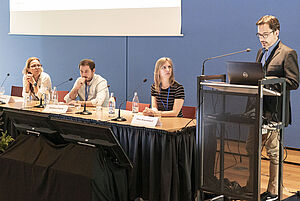Improving the impact of media-based learning
How can we improve the impact of our media-enhanced training initiatives? This question is at the heart of the educational community's reflections, as it faces major challenges such as the invasion of generative artificial intelligence and fatigue towards synchronous distance learning courses.
Michel Leroy spoke on this topic at the international Media & Learning conference in Leuven (Belgium) on 20 June 2024, in a presentation prepared with Dr Sara Namusoga-Kaale, from Makerere University in Uganda. Media & Learning is a community of around 12,000 individuals and organisations keen to maximise the benefits of media for learning.
This yearly conference was an opportunity to point out that this concern is particularly acute in the countries of the Global South, and in sub-Saharan Africa in particular, where the average enrolment rate in higher education is less than 10%, although growth is expected to be close to 40% over the next 5 years. Distance learning is often viewed with a degree of euphoria, although issues of access to technology, the need for culturally relevant formats and institutional resistance are still hampering the process.
Michel Leroy pointed out that the figures still show that learners are dissatisfied with what is currently on offer: 28% of them consider themselves to be "dissatisfied" and two-fifths of the under-25s have never used free online courses open to all (MOOCs), for example, as the studies carried out as part of the CoMMPASS project have shown. It is therefore essential to think in terms of learner engagement, and no doubt to envisage new forms of collaboration between the field experts who have to build digital-oriented content, the learning experts who ensure the coherence of the teaching progression, and the video pools responsible for producing innovative and appealing content that is in tune with the cultural references of the learners.
One must also bear in mind that digital uses are often disruptive: in Kenya last year, smartphone penetration rose from 54% to 61% in just twelve months, while feature phone use continues to decline. So we can't be satisfied with content for its own sake, however interesting it may be. We need to keep a close eye on tracking and opt-out rates to identify at-risk audiences and keep them involved. So this was a return to basics. As the title of the conference itself illustrates: Back to the future?

